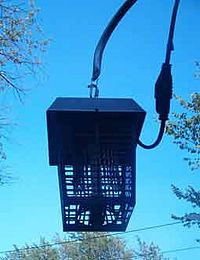Bug zapper

A bug zapper is a device that attracts and kills insects that are attracted by light. A light source attracts insects to an electrical grid, where they are electrocuted by an exposed high voltage electrical element. The name stems from the characteristic zap sound produced when an insect is electrocuted.
History
According to the US Patent and Trademark Office, the first bug zapper was patented in 1934 by William F. Folmer and Harrison L. Chapin. They were issued patent no. 1,962,439.
Design

Bug zappers are usually housed in a protective cage of plastic or grounded metal bars to prevent user contact with the high voltage parts within. Inside, a light source is mounted in the middle, often a fluorescent lamp designed to emit ultraviolet light, which is visible to and attracts insects. The light is surrounded by a pair of carefully spaced and electrically insulated charged wire grids. A voltage multiplier circuit (comprising diodes and capacitors) and/or transformer increases the voltage of a power source high enough to at least break down the dielectric formed (typically over 1,000 volts but lower voltages may be used) when an insect comes close enough to the mesh pair. An electrical arc is formed when the dielectric breaks down and current flows through the insect's body. The insect is electrocuted and then dried. An insect does not have to touch both wires, as an arc will form in an air gap over 1000 V; typically an arc will form 1000 V/mm, starting at about 1 mm.
Many bug zappers are also equipped with shallow trays that collect the remains of the electrocuted insects.
A novel variant is the manual bug zapper or electric flyswatter, which resembles a small tennis racquet strung with electrified wire. To use the device, one swats the insect, zapping it, and then collects and discards the insect.
Drawbacks
The count of mosquitoes collected by the trap is often low compared to that of other insects. Mosquitoes are more attracted to carbon dioxide and water vapor in the breath of mammals. The strong UV light in fact attracts many insects indoors or to the patio that would not otherwise be present. These other insects can be important pollinators of plants or otherwise necessary to the environment, and are harmless in any case.
When insects are exploded by the discharge, an aerosol of bug intestines is produced that is inhaled by or settles on the food of people in the room. While most of the harmless insects are unlikely to disease, mosquitoes killed by the zapper can be carrying the blood of humans or other animals.
Alternate Methods
There are several alternatives for the destruction of annoying insects. A product currently on the market releases an artificial pheromone for mosquitoes. The mosquitoes are attracted to the pheromones, and fly towards the source until they are caught in a net, where they die of dehydration. Citronella oil is another low-cost substitute for a "bug zapper". It is usually available in retail stores in the form of candles or wrist bands. DEET (N,N-diethyl-meta-toluamide or N,N-diethly-3-methylbenzamide) is also another excellent bug repellent and is availble at the same places listed above.
